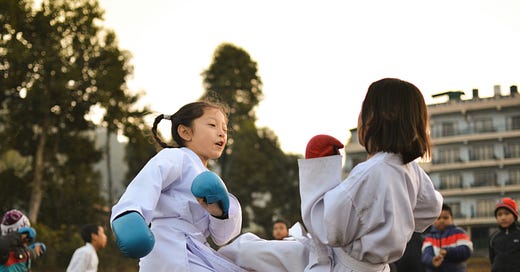Photo by Jyotirmoy Gupta on Unsplash
Being a teenager in 2025 is stressful. Smartphones, wars, polarization, GenAI, high stakes exams and competitive pressures, not to mention the standard fare of adolescence such as puberty, friendship, romance, and generally figuring out who you are. At the same time, stress is part of life. As a parent, it’s hard to watch your kids struggle, and it’s hard to know how to respond. Which is why I loved this study from Professor David Yeager, a professor of Psychology at the University of Austin Texas and author of 10 to 25: The Science of Motivating Young People, which we found in our research for The Disengaged Teen.
The study aimed to help teens lower their negative stress responses by changing how they thought about two things: their ability, and the role of stress. Specifically the researchers sought to teach kids about:
A growth mindset – the belief that their intelligence and abilities can improve with effort, which helps them feel more capable and less discouraged by challenges.
A stress-can-be-helpful mindset – the idea that physical signs of stress (like a racing heart) can actually be signs the body is getting ready to perform well, not signals of failure.
The results, published in Nature, were promising. TLDR: When we change how kids think about stress and struggle it can actually change how they respond to stress and struggle. The mind is indeed a mysterious and wonderful thing.
The rationale behind the research
This is how the researchers explain why they undertook the study:
“Conventional thinking portrays stress as mostly a bad thing to be avoided or kept at bay. But this ‘stress avoidance’ mentality ignores the reality that elevated levels of stress are a normal and, in many ways, even a desirable feature of adolescence. Adolescents must acquire a wide and varied array of complicated social and intellectual skills as they transition to adult social roles and prepare for economic independence. This developmental process is inherently stressful, but it is also essential to the task of becoming an adult.”
What the researchers did
The research included 5,000 secondary and post-secondary students in the US in a set of six studies. The “intervention” was a self administered 30-minute online module. Before participants did the module, they filled out surveys about their stress levels, academic attitudes, and emotional well-being. This assessed their starting point. Then they were randomly assigned either to a treatment group (which received variations of the mindset interventions) or a control group (which did another activity unrelated to stress or growth mindset).
Students then completed the 30-minute online module during a school session. It included explanations of how the brain and body respond to stress, testimonials and stories from older students, and writing prompts asking students to reflect on how they could use these mindsets in their own lives (these writing activities help to reinforce the ideas — a technique called "saying-is-believing”).
Afterward, students were followed up through surveys, academic records, and in some studies, biological measures (like cortisol levels) to see how the intervention influenced their stress responses and performance.
The results
Participants reported having more adaptive thoughts about stress, indicating a shift in how they perceive and respond to stressful situations. (Eg the kids improved how they thought about stress, or “stress-related cognitions”)
They had improved physiological response—healthier cardiovascular reactivity and lower daily cortisol levels—suggesting that the intervention positively affected the body's stress response systems
Participants experienced improvements in mental health and academic outcomes
The intervention helped alleviate anxiety symptoms amid the heightened stress of the pandemic
The combined approach of addressing both mindsets synergistically was more effective than targeting just one. In one of the studies, when kids were told that stress could enhance their performance, alongside the message that intelligence is not fixed but can be developed, they passed their math and science classes at higher rates, an increase of over 14 percentage points.
How kids thought about stress ended up changing how they reacted to it and, subsequently, how they did on tests.
“Although stressful experiences feel unpleasant in the moment, they are the path through which everyone who ever became really good at something got to where they are,” the authors noted.
I loved a story from Lisa Feldman Barrett, a psychology professor at Northeastern University and an expert on emotions. When her daughter was preparing for her black belt in karate, things were looking dicey. Her kid was tiny and her opponents were huge. The kid’s coach walked over, looked at the girl, and instructed her to “get her butterflies in formation.” He didn’t say “Don’t be stressed.” Harness it. Use it. It’s the brain’s way of preparing you to expend a lot of energy. How you frame it in your brain determines what your body does.
Not every stressful situation is the same. Parents need to look out for “unmanageable” stress versus uncomfortable stress (a distinction I learned from Dr Lisa Damour). But the Nature study’s findings remind us that some stress is ok, and can even be used to our advantage.
A note on timing: I have mentioned this study to my kids during exams. I can tell you it will go down better when you are not in the middle of them. So try it in September, and not just before finals.





